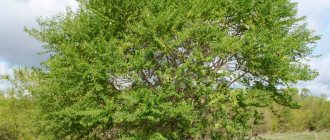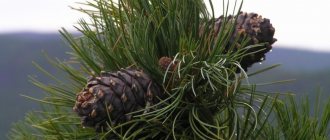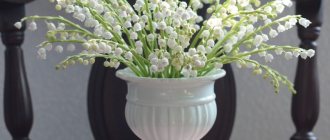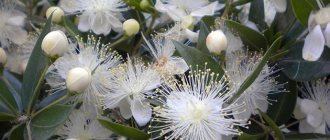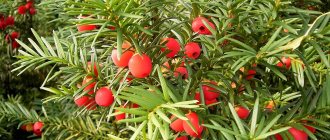Smooth elm tree photo leaf description
Latin name Ulmus laevis
Ulmaceae Mirb. – Elm
Smooth elm
Description
Smooth elm is a powerful, slender tree 25–30 m high and with a trunk diameter of up to 1 m.
The crown of the tree is dense and spreading, with thin hanging branches; the annual shoots are light brown, first pubescent, then smooth.
The bark is brownish-brown, peeling off in thin plates; In passing, we note that the elm has bare gray bark, with deep cracks, and also flaking.
The leaves are elliptical or obovate, asymmetrical at the base, that is, not lopsided, double-toothed along the edge, 6-12 cm long, usually glabrous above, dark green, and pubescent below, with a pointed apex.
The flowers are inconspicuous, brown, on a peduncle up to 1-2 cm long, collected in bunches or capitate inflorescences, bisexual, wind-pollinated. It blooms in April-May before the leaves bloom, and the elm is bare even in March or April.
The fruit is an elliptical lionfish, flattened, membranous, 12-16 mm long, with a nut located in the center, ciliated along the edge; the stalk is 2-3 times longer than the lionfish itself. Fruiting begins in late spring or early June.
Spreading
The genus elm (elm) includes up to 45 species living in Eurasia and North America, and in Russia - 8 species, of which the predominant one is smooth elm, as well as naked elm.
Smooth elm is a common tree species in the European part of Russia, the northern border of its range reaches Lake Onega, in the south - all the way to the Caspian deserts, in the east it wedges into the areas adjacent to the Ural Mountains, without crossing them. It grows mainly as an admixture in lowland broad-leaved forests in the first and second tier together with oak, maple, linden, and also in open areas along river floodplains in the form of single trees or small groves. In steppe areas, elm is found in ravine clusters of trees, on the slopes of terraces of river valleys, preferring chernozems. In the Caucasus Mountains, elm rises to a height of up to 1400 m above sea level. Elm (elm) forests are found in the center and southeast of the Russian Plain, the Southern Urals and the Far East, their tree stand includes oak, sedge, alder and aspen, and in Caucasus - ash, beech, walnut.
Description of the genus
Elm (from Latin ulmus laevis) is compared to oak in its majesty and power. This is a relict species, the lifespan of which trees goes back several centuries. The growing area of elm species is extensive; in Russia they are found in several subspecies; in addition, they can be seen in North America and Europe.
This genus of trees is found both as single representatives and in mixed plantings. They also feel quite good in poor soils, but mostly grow on fertile lands. This type of tree grows upward even when there is not enough sun. At the same time, the growth rate of elm is very high. The growth per year is about 50 cm in height, and in trunk girth up to 0.3 meters.
A mature elm can reach 40 meters, but there are also species that resemble shrubs. The surface of the bark of a young elm is without roughness, light brown in color, and over time it becomes covered with vertical grooves. The root system of the tree is powerful, the roots penetrate to a depth of 30 meters with a trunk with a girth of 1.5 meters. But some species have their roots spread out rather than deep, covering vast areas.
Elm leaves differ significantly from other species in their elongated oval shape and jagged edges. Leaf size is from 4 to 20 centimeters. They are located alternately on the branches and are attached to them with short cuttings. In autumn they change color from green to red-brown and the crown quickly thins out.
The tree blooms in the spring, before it becomes overgrown with leaves. The inflorescences are small, yellow in color. Elm seeds are small winged nuts. They ripen in the last days of May, and the wind scatters them throughout the surrounding area. If the conditions are right, they can germinate within a few days.
Interesting Facts
Elm is an unusual tree; many legends and historical facts are associated with it:
- In Russia they believed that elm branches brought good luck, courage and protection to travelers on long and difficult journeys.
- In Christianity, the tree is sacred. This is a symbol of honor and dignity.
- For many, elm is a symbol of family and motherhood.
- Elm wood was used as supports in the construction of the first London Bridge.
- In Venice there are buildings on elm stilts.
- In Korea, the long-lived elm tree was reported to be about 800 years old. Its height is 7 m, trunk diameter is about 2 m.
- Until 2010, an old elm tree grew in Moscow, which managed to survive the fire of 1812. Due to the unnatural heat, it dried out.
- The tree exudes a pleasant soothing and relaxing aroma.
- In China, wings are added to various salads.
- In the Middle Ages in Europe, water pipes were made from tree trunks.
Elm is a long-lived deciduous tree with a beautiful spreading crown. The wood is valuable, has an unusual pattern, is durable and is used for a variety of purposes. The bark, leaves and roots are used in traditional and folk medicine.
Types of elms
Elm is the most common species of elm. It easily adapts to negative weather conditions and tolerates temperatures down to -28 °C. Popular tree subspecies include:
- The elm is smooth, stretches up to a height of 25 meters, the table is covered with bark with a pronounced relief, of a dark brown hue. The leaves are large. Elm differs from other varieties in the shade of its foliage; it is dark green on one side and light on the other, covered with a light fluff. The flowers of this tree are purple with a hint of burgundy.
- The squat elm, living up to its name, is small in size. It reaches a height of up to 15 meters and often looks like a bush. Most often found in the Far Eastern region. The leaves are small, soft green in color. Inflorescences are yellow-brown, small.
- Rough elm. Grows in rich soils. Most often found in mixed forests. The trunk is covered with smoother bark than other species. Reaches 40 meters. The foliage is large, green, with an uneven surface.
Historical information
The name smooth elm comes from the Celtic “elm”, which means elm. In Rus', this word was interpreted as a “flexible rod” and the wood of this tree was used for the production of carts and sleighs. Using the flexibility of elm, our ancestors used it as a good building material and also made weapons. This tree was used to make household utensils: arcs, shafts, knitting needles and much more.
The bark of the tree was used for tanning leather, and the bast of this tree was used to make bast. Leaves and young shoots were fed to livestock.
Planting and care
Planting elm in the local area is not difficult. You will need ripe, dried seeds. Shoots appear a few days after immersion in the ground. It is important to remember that germination quickly disappears, so it is important not to waste time. Elm fruits should be planted according to the following algorithm:
- It is necessary to collect the seeds after flowering has completed. After this, they are placed in nutrient soil or wet cotton wool. It is advisable to pre-treat the fruits with anti-fungal agents.
- After a few days, the seeds are planted in a container with soil. The best choice in this situation would be black soil, as this will increase the growth rate. But humus with leaves will also work. Be sure to choose a soil that is soft and sufficiently moist.
- The seeds are immersed to a depth of 1-2 cm, the distance between the holes should be approximately 25 cm. The ground is covered with moss, dry grass or cotton wool. The soil is moistened every day. After 10 days, you can see the young elm and remove the covering material.
It is advisable to frequently place the sprouts in the sun. In the absence of precipitation and wind, it is good to leave the container with young sprouts on the balcony or in the garden in the air. During the first year, the plant reaches 20 cm. The seedling can be planted in the ground in the second year.
In the first years, elm must be protected from excessive wind and low temperatures. For the winter, the tree must be covered with special material. It is important to remember that soil saturation affects how roots form, so poor soil needs to be fertilized. It is also important to regularly loosen the soil around the shoot.
Over the course of a year, the elm grows 40-50 cm in height. The branches are not pruned for 1-2 years; the crown is required to form. Only diseased or dry branches should be removed. It is permissible to trim the crown while the seedling is growing.
Tree variety
A twenty-meter tall tree with a lush green crown that loves the sun is called Hornbeam Elm. Elm leaves have a dark green (bottle) color and an oblong, jagged shape with a smooth surface. The trunk is not smooth, and there are corky growths on the branches. It blooms with a reddish inflorescence for quite a long time, after which it is overgrown with leaves that have a rich yellow color in the fall. The fruitful lionfish reaches twenty millimeters. This view decorates the park area with a dense plant wall.
The dense elm has a drooping, dense crown of leathery leaves. Elm grows up to thirty meters even in drought conditions and has dark furrowed bark.
Coniferous and deciduous forests, where there is a lot of shade, are complemented by Lobed Elm, which can withstand frosts down to minus thirty degrees.
The wild elm, which is observed in Siberia, Kazakhstan and East Asia, is called Euonymus or Pinnately branched elm, Karagach. The scorching sun in these areas does not prevent the tree from developing on sandy and rocky soil, where the salt content is high. A tree of this type is the size of a five-story building. The leaves are feathery, smooth, small and collected in openwork bunches, and the bending branches are thin. Due to the sparse crown, there is little shade from the elm, but planting an ornamental tree in city squares and parks, with appropriate care and pruning, can help enrich the area with oxygen and create a recreation area in the summer.
The Squat Elm has a rounded crown of small leaves and a small height. In the urban conditions of the central part of Russia, it is possible to grow this tree, but it is difficult, since the elm is not very winter-hardy and loves fertile soil with plenty of moisture.
Among the elm varieties, the following are also noted:
- Japanese elm or birch bark;
- Mountain or rough elm;
- Androsova elm;
- English elm.
Trees differ in size, flowering period, shape and structure of leaves, flowers, stem bark, fruiting cycle, and resistance to soil and weather conditions.
The described types of elm can help in choosing a plant to plant for decorative purposes.
Diseases and pests
Typically, elm is affected by elm springtail, scale insects, and leaf beetles. It is easy to identify a disease in a tree; its crown dries out and growths appear on the bark. To combat parasites, treatment with liquid copper sulfate, insecticides and fungicides is used.
Young trees are easier to get rid of diseases. Old elms are difficult to get rid of parasites, especially fungi. That is why the use of antifungal agents is recommended at the planting stage.
Etymology of the name
It turns out that “Elm” is not the only name for the tree. The Latin name for the tree is “ulmus”. In addition, there are common names: Ilm, Berest and Karagach.
Why Elm? The name comes from the fact that in the old days they extracted bast from a tree trunk and knitted rims, sleighs and many other useful things from it.
Meaning and Application
It is difficult to overestimate the importance of elm. Its bark, fruits and leaves are successfully used in folk medicinal recipes. It is important to talk to your healthcare professional before using elm in the treatment of various diseases. Therapy has side effects and contraindications.
Decoctions based on bark and leaves help reduce inflammation, have antibacterial properties, and help heal damage. The extract is used for the treatment of kidney, heart, blood vessels, thyroid gland, etc.
A decoction is useful for throat diseases. So, if you have a sore throat, it is recommended to gargle with it. Tea from the leaves is used for constipation. In case of hemorrhoids and kidney diseases, baths with elm bark are recommended. The tincture is used to get rid of skin rashes.
Elm wood is often used in industrial production due to its excellent properties. Elm wood is often used as an alternative to expensive wood species. Its texture allows you to imitate valuable varieties, with a fairly light color. Mahogany connoisseurs love elm. Elm is used to make furniture for the home and is also used to make paintings.
The density of elm wood is very high, approximately 600 kg/m3. The cut of wood has a beautiful texture, which makes it suitable for use in carpentry. It is resistant to rotting processes and is difficult to split and saw. However, it behaves very well when polished.
In the old days, elm was also used in carpentry workshops, and paint was made from its bark. Without taking into account the pests that attack the tree, it is often planted in parks, around the city, and in social institutions.
Medicinal properties for humans
In fact, there are a lot of medicinal properties here. Let's start with the fact that it can have anti-inflammatory, antimicrobial, wound-healing and diuretic effects. In what form can it be used? You can make decoctions from leaves and bark.
Also make baths, tinctures and teas. Do not forget that a decoction of the leaves is used in case of joint disease. If you suffer from any skin disease, it can also help you.
The main diseases for which you should use Elm in your treatment:
- Syphilis;
- Gastrointestinal diseases;
- Normalization of metabolism;
- Normalization of the cardiovascular system;
- Thyroid diseases.
It is worth noting that it is also used as a sedative.
Use in landscape design
The elm looks like a mighty, strong tree with a dome-shaped crown. It is the dense foliage that allows it to be used as a barrier against dust, gases, and dirty air for residential areas. Moreover, in addition to such an important practical function, elm forms a beautiful, green landscape.
The crown of elms is often used to create shapes in landscape designs. The density of the branches allows you to cut a wide variety of shapes. Powerful, strong roots of the tree can strengthen the banks of lakes, rivers, and the slopes of ravines. Thus, planting elm, in addition to its decorative function, will fulfill an important, practical role.
Elm is an excellent solution for a personal garden. In addition to the obvious landscaping, it will strengthen the soil. Thanks to this, fertile soils will not slide and will be preserved from weathering and erosion.
When deciding to plant elms, it is important to take into account their subspecies and dimensions. Since the diversity of elm is great, there are both miniature and huge specimens.
So, a tall, spreading tree is not suitable for a small area. And over a large area there will not be enough bushes.
How to prepare a decoction
The root of this plant is used to prepare a decoction, which is used as a lotion for eczema and purulent wounds.
The decoction is also considered effective in combating the most dangerous disease in the world - cancer.
- To prepare a decoction, pour boiling water over the bark or roots and simmer briefly over the fire.
- Then give the resulting liquid time to brew; it should decrease several times.
- Of course, the resulting liquid will be very strong, so you will have to add water, that is, dilute it.
- Next, strain the resulting tea for subsequent oral administration no more than twice a day. The maximum you can take is one tablespoon.
